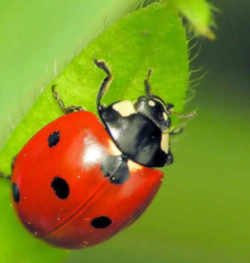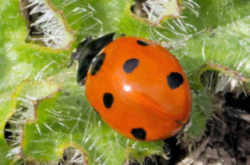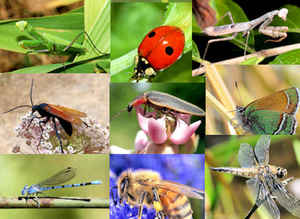Delaware State Bug
Ladybug

(Coccinella 7)
Adopted on April 25, 1974.
The Lady Bug was chosen by the Legislature after an intensive effort on the insect's behalf by Mrs. Mollie Brown-Rust and her 2nd grade students of the Lulu M. Ross Elementary School in Milford, Delaware. It was adopted on April 25, 1974.
The Ladybug is the Official State Insect of six states; New York, North Dakota, Ohio, Massachusetts, New Hampshire and Tennessee. The Lady Bug is the Official State "Bug" of Delaware.
Delaware State Bug: Ladybug

The ladybeetle, more commonly called ladybug or ladybird beetle, is the popular name given the Coccinella 7. This beetle was dedicated to the Virgin Mary and called "Beetle of Our Lady." They are around four-tenths of an inch long, brightly colored, round, with the popular ladybug having four black spots on each wing. Ladybugs are sold to farmers to control insect pests because they are important aphid predators. The life cycle is about four weeks as the ladybug larvae passes through four growth stages feeding on insects and insect eggs. The reddish-orange ladybug has distinctive black spots on each wing cover.
It helps farmers by controlling insect pests, especially aphids. In folk medicine, ladybugs were believed to cure various diseases such as colic and measles. In folk medicine ladybug beetles were used to cure various diseases including colic and the measles.
Characteristics of the Ladybug
Adults: Small, domed usually hemispherical. Head sunk into pronotum. legs short and retractable; tarsi 4-segmented but 3rd segment very small and concealed in bi-lobed 2nd. 7 Black spots on bright red. Adults may be seen from March to October.
Defense: Bright colors generally indicate that the insect is armed and dangerous! In this case the ladybird is advertising it's bitter taste. When handled the ladybird will exude drops of pungent fluid which stain the hand and taint it with a long-lasting smell.
Feeding: As with most in this family, ladybirds will eat huge numbers of aphids in both the larval and adult stages
LARVA: carnivorous, aphids
Some Facts About Ladybugs:
- Ladybugs are the most popular and widely used beneficial insects for commercial and home use. Ladybugs are capable of consuming up to 50 to 60 aphids per day but will also eat a variety of other insects and larvae including scales, mealy bugs, leaf hoppers, mites, and various types of soft-bodied insects, and are one of the most active predators, searching from dawn to dusk for food.
- Ladybugs will consume over 5,000 aphids each in their lifetime. Pollen and nectar are necessary for maturation of newly emerged ladybug adults, particularly before a winter hibernation season. Adults can survive on pollen and nectar for limited periods, but a supply of aphids or other prey is necessary for egg production.
- Ladybugs become active at about 59 degrees Fahrenheit.
- Ladybugs are cold-blooded and hibernate in cold weather.
- There are nearly 5,000 different kinds of ladybugs worldwide - 400 of which live in North America.
- A ladybug's top flying speed is about fifteen miles per hour.
- Ladybugs lay their eggs where aphids are present. Both lady bugs and their larvae eat aphids. The eggs of ladybugs are not visible to the naked eye.
- A female ladybug will lay more than 1000 eggs in her lifetime.
- Ladybugs are a type of beetle. All species of ladybugs have short legs. This separates them from other beetles.
- Ladybugs chew from side to side and not up and down like people do.
- The Ladybug is the Official State Insect of six states; New York, North Dakota, Ohio, Massachusetts, New Hampshire and Tennessee. The Lady Bug is the Official State "Bug" of Delaware.
- A ladybug excretes a yellowish liquid when it is threatened. The liquid has a terrible smell to its predators.
- The Asian Lady "Beetle" can live up to 2-3 years if the conditions are right.
Delaware Law formerly HOUSE BILL NO. 667
CHAPTER 300
FORMERLY
HOUSE BILL NO. 667
AN ACT TO AMEND CHAPTER 5, TITLE 29, DELAWARE CODE BY PROVIDING FOR THE DESIGNATION OF THE OFFICIAL BUG OF THE STATE OF DELAWARE.
WHEREAS, students in the Milford High School District have found that the State of Delaware has omitted from the Delaware Code the official designation
of a State bug; and
WHEREAS, many states have designated an official State bug to accompany their State flower, State flag and State bird; and
WHEREAS, the insect herein designated as the official State bug is emblematic and fitting to accompany Delaware's other official symbols.
NOW, THEREFORE:
Be it enacted by the General Assembly of the State of Delaware:
Section 1. Amend Chapter 5 of Title 29, Delaware Code, by adding thereto a new section to be designated as §509 to read as follows:
§509. State bug
The Lady Bug shall be the official State Bug for the State of Delaware.
Approved April 25, 1974.
The law designating the lady bug as the official Delaware state bug is found in the of the Delaware Code TITLE 29, State Government, General Provisions CHAPTER 3. STATE SEAL, SONG AND SYMBOLS, Section 309
TITLE 29
State Government
General Provisions
CHAPTER 3. STATE SEAL, SONG AND SYMBOLS
§ 309 State bug.
The lady bug shall be the official state bug for the State.
Taxonomic Hierarchy: Lady Bug
Kingdom: Animalia (Animals)
Phylum: Arthropoda (Arthropods)
Subphylum: Hexapoda (Hexapods)
Class: Insecta (Insects)
Order: Coleoptera (Beetles)
Suborder: Polyphaga (Water, Rove, Scarab, Long-horned, Leaf and Snout Beetles)
No Taxon: (Series Cucujiformia)
Superfamily: Coccinelloidea
No Taxon: (Coccinellid group)
Family: Coccinellidae (Lady Beetles)
Subfamily: Coccinellinae
Genus: Coccinella
Species: Coccinella 7
Butterflies, and Bugs








